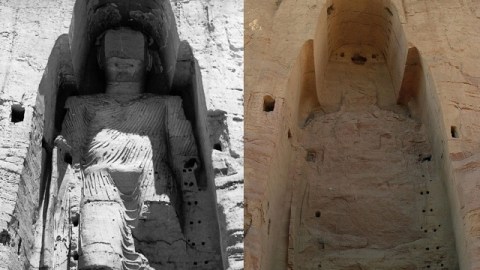Should the Bamiyan Buddhas Be Rebuilt?

When I read the news that the Bamiyan Buddhas, the giant 6th century statues in Afghanistan destroyed by the Taliban in March 2001, would not be rebuilt, I had mixed feelings. To rebuild or not to rebuild? That is the question. On one hand, is not rebuilding them a way of letting the bad guys “win”? On the other hand, is there any way we can really rebuild them? The approach being taken in Afghanistan isn’t necessarily the “right” one, but it might be the right one for them. But might it also be the right one for us?
I don’t think I had ever heard of the Taliban before the news that they had dynamited the two giant Buddha statues in March 2001. Mullah Mohammed Omar ordered the “hit” after the statues (shown above, before and after the blasting) had been deemed false idols by the Taliban’s leadership. Six months later, the whole world knew about the Taliban after the events of September 11th. Taking down these statues looks now like the Taliban’s prequel to the big show in New York City and Washington, DC, something they even went so far as to film and turn into a propaganda video. Because the loss was more historic and cultural than something measured in human lives, the destruction of the Bamiyan Buddhas has been overshadowed by 9/11, at least outside of Afghanistan, until now.
In America, there never seemed much doubt that the World Trade Center would be rebuilt in some way. Our symbolic act of rebuilding had to win out over their symbolic act of destruction. Just to make things perfectly clear, the new One World Trade Center, originally known as “Freedom Tower,” is 1,776 feet tall. Architecture became war by other means. Different ideas of how to rebuild the Buddhas were in the works, ranging from completely new carvings to reassemblings of the exploded fragments held together with modern materials. There was never any fear that the results would more resemble something found outside a P.F. Chang than the beloved, ancient, sacred sculpture. And, yet, the final decision is to leave the Buddhas be, or not be, depending on how you look at them.
The title of the article in The Art Newspaper about the decision says it all: “The Victory of the Void, a Defeat for the Taliban.” “The void is the true sculpture,” explains Andrea Bruno, an architectural consultant to UNESCO for the past 40 years and leader of the Bamiyan project. “It stands disembodied witness to the will, thoughts and spiritual tensions of men long gone. The immanent presence of the niche, even without its sculpture, represents a victory for the monument and a defeat for those who tried to obliterate its memory with dynamite.” For a Buddhist culture, the idea and spirit embodied by the statues remains, even if the physical stone lies in ruins. They don’t see a need for a “take that” moment of materialized symbolism. For them, to play that kind of symbolic game would be to acknowledge the Taliban in some way and give them a “victory.” For America, it would have been as if we had been satisfied with the ghostly illuminated memorial Tribute in Light and allowed the idea and spirit of the Twin Towers and those who lost their lives there to take precedence over real estate. Instead, we gained a building, but what did we lose in that exchange. Is the new World Trade Center building really a victory for the Taliban?
Ironically, the loss of the Buddha statues was also a gain. When the statues fell, 50 caves were exposed, 12 of which contain wall paintings dating from the 5th to 9th centuries, probably painted by artists traveling along the Silk Road who wanted to pay tribute to the holy site. In 2008, a third Buddha statue—a reclining pose that stretches 62 feet long—was found by researchers actually looking for a much larger statue alluded to in ancient legends about the site. Perhaps that bigger discovery still awaits. I don’t think that we’ll find hidden caves or lost statues at Ground Zero, but if we had approached the memorial site in a different way, such as they are in Bamiyan, perhaps we could have discovered something new, and bigger, about ourselves.




